

The Thankful Issue
THE LAST TOBACCO FIELDS OF MISSOURI
THE STORY OF THE KRASNESKY MANOR FOR WAYWARD CATS









As the Northland’s premier destination for health, our specialized orthopedic team helps you enjoy active, pain-free living at every stage of life. With advanced treatment options in joint care and sports medicine – including surgery, non-surgical care and specialized rehabilitation – we keep life in motion.
From winning championships to staying fit and dancing the night away, choose Liberty Hospital Orthopedics when you need care that always keeps you moving forward.
Thankful for local history
Our cover story this month is one I’ve been passionate about for a while now and have spent over a year documenting. I live in Weston and while I’m not from this area, I find that that makes me all the more curious of the town’s storied history. Tobacco has been important to Weston for a long time, and while its beautiful countryside is dotted with tobacco barns, the tobacco that used to cure inside them is disappearing year after year.

I set out to document what may be the last days of tobacco in Platte County and found a local farmer, Lennie Callaway, who is so passionate about the crop. As I started to document Lennie and his tobacco farm, I realized he had a fountain of knowledge about tobacco that may not be carried on to future generations. And with the crop disappearing from Missouri farms, I started to become desperate to attempt to document his expertise in any way I could — taking thousands of photos, capturing clips on video and asking any question my non-farmer brain could think of.
It’s been such a joy to spend time with Lennie among his rows of tobacco, inside the aromatic barn and in the tin-roofed stripping shed. I set out knowing nothing about the tobacco plant or its importance to Platte County, and though I still don’t feel like I know all there is to know, I feel proud to have attempted to chronicle an important part of its history before it disappears.
It’s also a great joy to fill this magazine’s pages with you every month, full of local stories from amazing people, with the fantastic talent of our local photographers and writers. In addition to my tobacco story, we have an absolutely beautiful story about a historic home in Leavenworth, written by its owner Thad Krasnesky and accompanied by photos from Arin Yoon — both of whom have ties to the military community, which I always find important during the month that holds Veterans Day. And we also have a fun story from one of my favorite writers, the always-reliable Diana Lambdin Meyer and her photographer husband Bruce N. Meyer, who traveled throughout the Midwest to explore its Bigfoot lore.
Whatever this month brings you, I hope it’s hearty food, people to share it with and good stories to tell.
Until next month,
KATIE CURRID, EDITOR @NORTHLANDCITYLIFESTYLE
PUBLISHER
Chelsey Juarez | chelsey.juarez@citylifestyle.com
EDITOR
Katie Currid | katie.currid@citylifestyle.com
CONTRIBUTING WRITERS
Thad Krasnesky, Diana Lambdin Meyer
CONTRIBUTING PHOTOGRAPHERS
Bruce N. Meyer, Arin Yoon
Corporate Team
CHIEF EXECUTIVE OFFICER Steven Schowengerdt
CHIEF OPERATING OFFICER Matthew Perry
EXECUTIVE DIRECTOR OF HR Janeane Thompson
AD DESIGNER Josh Govero
November 2024 Visit our Instagram
LAYOUT DESIGNER Emily Lisenbee


Proverbs 3:5-6




inside the issue


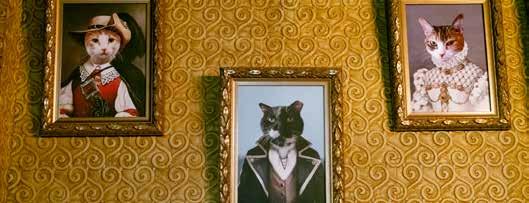
Wild Things
A Place For Lost Things
The
Wayward Cats
The Last Tobacco Farms of Missouri
Katie Currid


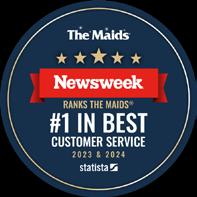
business monthly




Park Univ. Pianist Takes Second at International Competition
Tatiana Dorokhova, a graduate piano student in Park University’s International Center for Music, placed second in the piano section of the 2024 George Enescu International Competition in Bucharest, Romania. Dorokhova won a 10,000 EUR prize (approximately $11,125), as well as a 2,000 EUR (approximately $2,225) prize for the best performance of an imposed work.
Scan to read more
Local book release: Armored Hours
Local author Stephanie Hansen's book, Armored Hours, comes out this month on Oct. 15. The book is Cable Girls meets Peaky Blinders meets Titanic. Set in 1920s Paris of the Plains, Armored Hours is a thrilling tale of love and mystery interwoven with hints of magical realism. Find more information at authorstephaniehansen.com










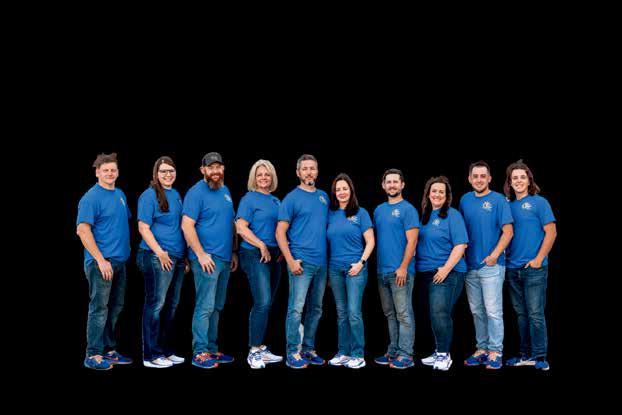


We heard you.

At WellWay Liberty, we elevate wellness with a fully personalized experience—no hidden fees, no long-term contracts Enjoy a premier wellness destination designed to meet your needs and seamlessly fit into your lifestyle
Join WellWay Liberty and experience:
A dedicated Wellness Advisor who will craft a custom wellness plan, guiding you toward the ultimate health experience
Personalized, data-driven health assessments to track your progress and achieve your goals
Unlimited Normatec Compression Therapy for faster recovery and enhanced performance
Two Dry Float Therapy sessions per month for deep relaxation and stress relief
Luxury amenities like our whirlpool and sauna you won’t find anywhere else
Expansive fitness floor with functional training turf
Over 75 group fitness classes per week
Indoor aquatics center
This is wellness on your terms expert support, advanced recovery services, and no commitments
Membership is not required to use health services at WellWay!


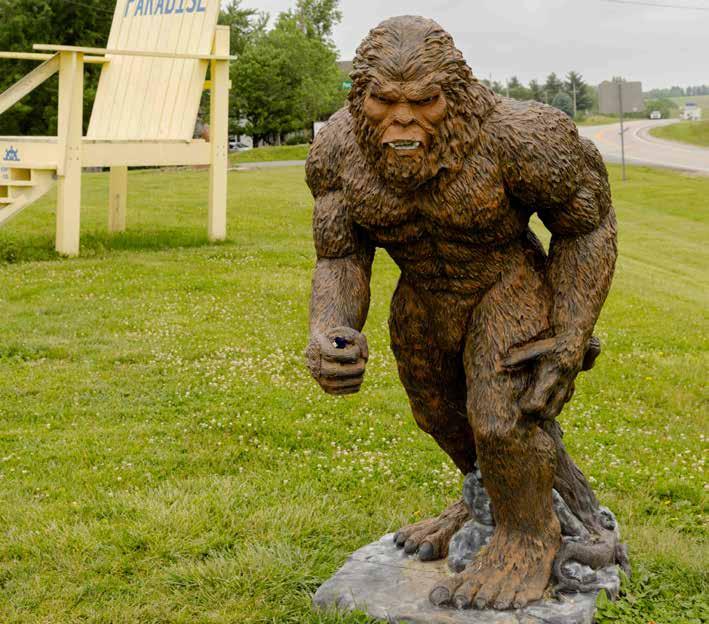
Legends of Bigfoot and other mysterious creatures across the Northland and beyond
Wild Things
ARTICLE BY DIANA LAMBDIN MEYER PHOTOGRAPHY BY BRUCE N. MEYER
Captain's Corner.
Photo by Katie Currid
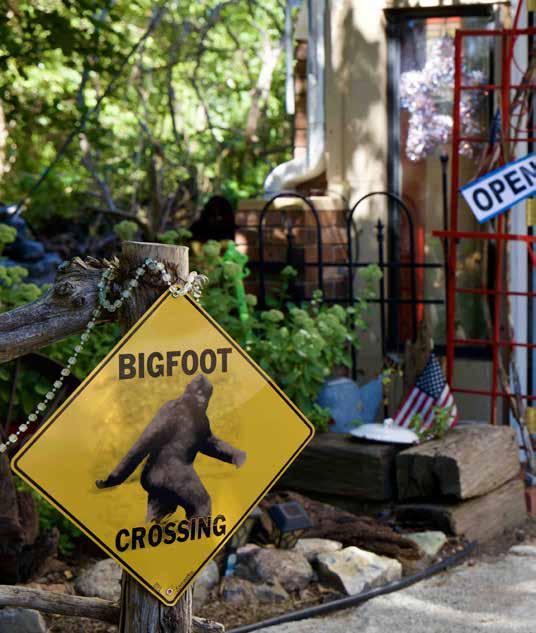

A mystery hides in the rolling hills of Clay County surrounding Smithville Lake. Clues can be found off County Road W in the little community of Paradise.
The footprints in the parking lot. The shadowy figure. And, oh, the smell.
The smell, actually, is more of an aroma leading to one of the best hamburgers in the Northland cooking up on the grill at Captain’s Corner. The burger is two pounds of meat and a pound of tater tots. It’s called the Bigfoot Burger.
“I don’t have an obsession with Bigfoot,” says owner Katherine Wald, “but I wonder…”
Katherine’s lifelong fascination with Bigfoot materialized in 2021 when she installed a Bigfoot sculpture outside the business and printed big footprints across the parking lot.
That’s also when she initiated “the Bigfoot Challenge.” Eat the entire twopound burger and tater tots in less than 30 minutes and you get, in addition to an immediate rise in your cholesterol level, a T-shirt. In the past three years, 60 customers have tried. Only 30 have succeeded.
“I just think the whole idea of Bigfoot is a lot of fun and it brings people together,” she said. Katherine has hidden 12 Bigfoot images around Paradise and is working on a scavenger hunt-type event to debut next summer.
Other than the burgers and creative fun in Paradise, there’s been little Bigfoot activity around Smithville Lake. About 20 years ago, some college kids reported seeing something late at night, but that’s about it.
Mitch Jackson is a natural resource manager for the Corps of Engineers and spends a lot of time outdoors in Clay County.
“You would think this would be a good spot for Bigfoot, but I’ve not seen anything or talked to others who have seen anything,” he says.
Bigfoot Museum

Bigfoot footprints in Smithville.
Photo by Katie Currid.
“You would think this would be a good spot for Bigfoot, but I’ve not seen anything or talked to others who have seen anything.”
There’s not a lot of activity around Weston either, although the city hosts a Bigfoot Search each April. The idea is to visit shops and search for clues. The winners receive a Bigfoot statue donated by Beverlin’s Statuary at 419 Main Street.
While there are several conferences and festivals to enjoy around the country and Midwest, the closest Bigfoot museum is about four hours away in Hastings, Nebraska.
This is where, in the 1950s, Harriett McFeely found a woolly mammoth bone while exploring the banks of the Republican River. Little eight-year-old Harriet entered her find in a school science fair and won first place. That was the beginning of her lifelong interest in anthropology.
About the same time, she saw a news report of Sir Edmund Hillary climbing Mt. Everest. There, where no human had
ever been before, Harriett saw a large, non-human footprint in the snow as big as a pickax. She began to wonder what else was out there.
Over the years, Harriett attended conferences across the country and personally investigated Bigfoot sightings in Nebraska and beyond. These experiences are the basis of the Bigfoot Crossroads of America Museum that opened adjacent to Harriett’s home in Hastings in 2017.
When we visited, the first thing Harriett asked was “Are you a Bigfooter?” No one had ever asked me that before.
Harriett is a Bigfooter, but a more accurate term is cryptozoologist – a person who studies mysterious animals whose existence is disputed. Bigfoot is a cryptid. So is Sasquatch. And the Loch Ness Monster and Florida’s Skunk Ape. You get the idea.
“I just think the whole idea of Bigfoot is a lot of fun and it brings people together.”
Harriett takes in stride that not everyone shares her belief in Bigfoot. She unabashedly leads you through exhibits that showcase footprint castings, woven tree saplings and braided horse manes.
In addition to developing her museum and researching Bigfoot sightings, Harriett coordinates the Nebraska Bigfoot Conference in Grand Island each April.
So, I told Harriett about the Big Muddy Monster in southern Illinois. That’s where I grew up, where the Big Muddy River flows into the Mississippi. Every time the rivers rise above flood stage, sightings of a large, hairy, smelly creature begin. The belief is that the Big Muddy Monster lives in a cave in the LaRue-Pine Hills that floods when the rivers are out of their banks. When in high school, my friends and I went on several escapades searching for the critter with no success.
Harriett was fascinated and took notes. At slightly more than 5 feet tall with a shock of bright red hair,
For more information on the Hastings Bigfoot Museum, visit nebraskabigfootmuseum.com or visithastings.com, (Hastings is also the birthplace of Kool-Aid, so double reason for a visit). You can find the Bigfoot Burger and its footprints at Captain’s Corner in Smithville, captainscornerparadise.com.
BIGFOOT AND OTHER CRYPTID EVENTS
Nebraska Bigfoot Conference, Grand Island, April 25-26
Big Muddy Monster Festival in Murphysboro, IL, June 23
Bigfoot Search, Weston, April 26
Ohio Bigfoot Conference, Salt Fork State Park, May 3
Bigfoot Days, Remer, MN, July 11-12
Indiana Bigfoot Conference, Nashville, IN, Sept, 28-29
Ozark Mountain Bigfoot Conference, Springfield, Sept. 27
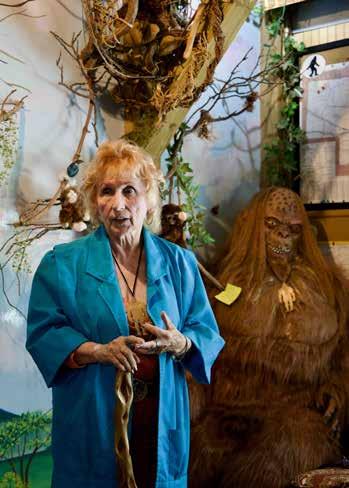
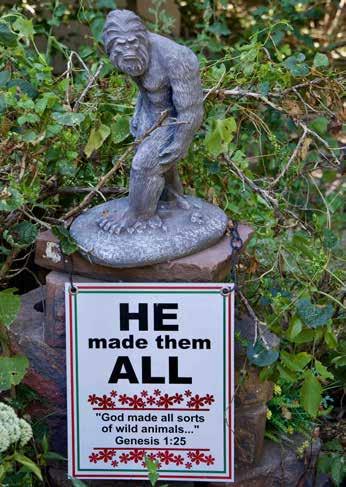
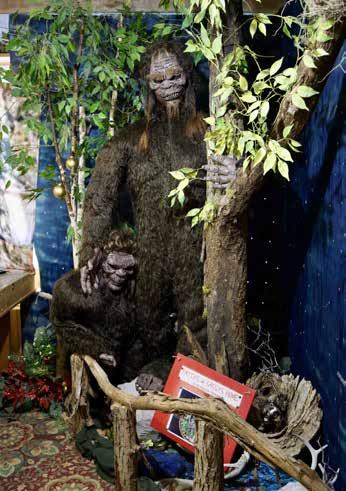
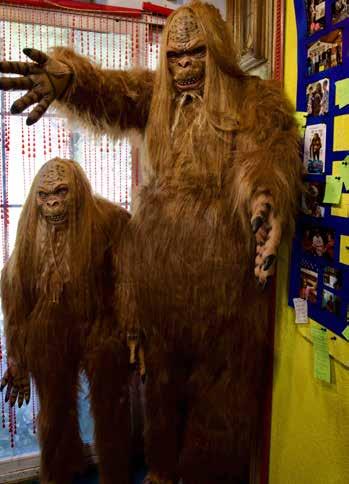
Bigfoot Museum in Hastings, Nebraska.








A PLACE FOR LOST THINGS
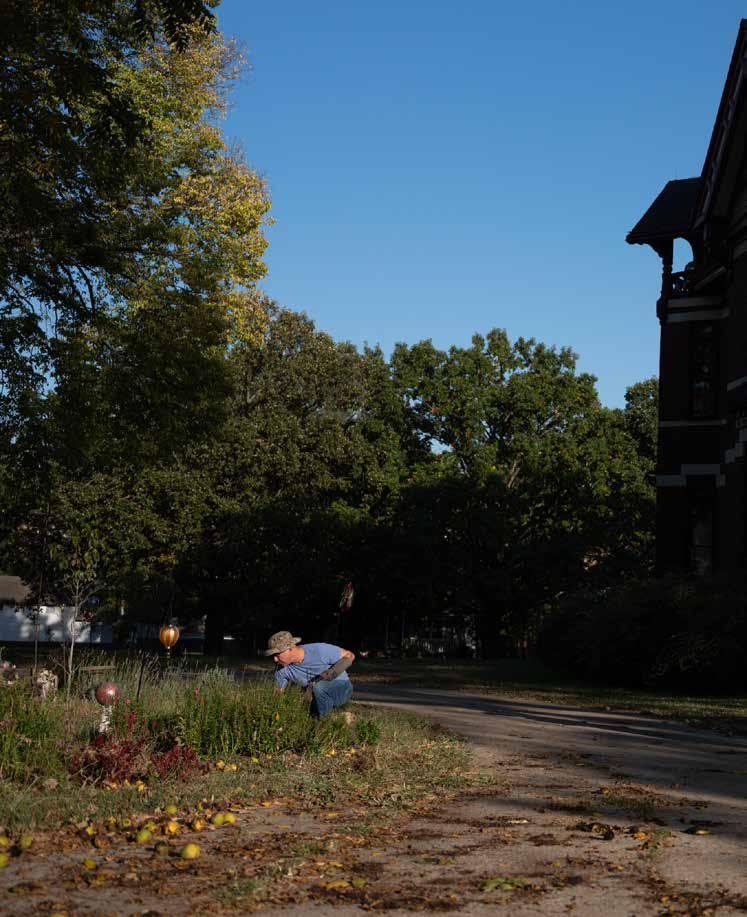
ARTICLE BY THAD KRASNESKY | PHOTOGRAPHY BY ARIN YOON
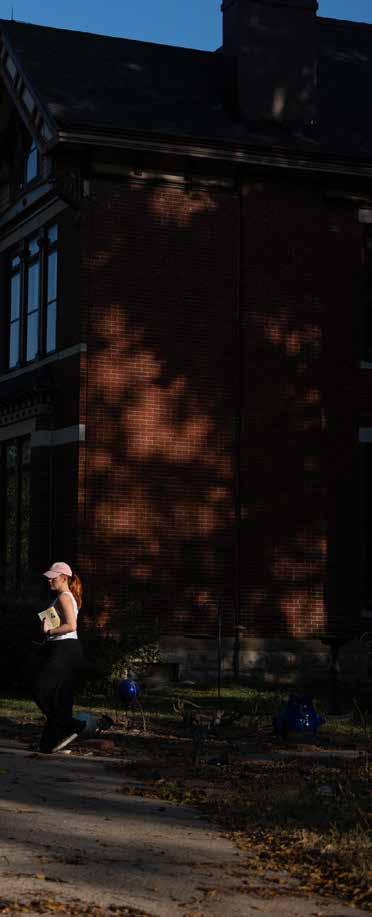
THE ORIGIN STORY OF LEAVENWORTH’S KRASNESKY MANOR FOR WAYWARD CATS
Somewhere not quite over the rainbow, not completely in this state or in that one, with one foot in a town on the Missouri River and one foot perhaps in Narnia or maybe in Willy Wonka’s Chocolate Factory, sits a Victorian mansion that is beginning to reawaken. For years it was abandoned — lost, in plain sight, as only enchanted things have the capability of being. And as with many enchanted things, it took a little blood and a few tears for the magic to be rediscovered.
The home is listed on the National Register as the Angell Mansion, but it has come to be known as the Krasnesky Manor for Wayward Cats. My wife and I purchased it in 2021, four days before Christmas. The three-month saga that began that September, and ended with us sitting at our sixteen-foot-long dining table, eating delivery pizza and drinking champagne, is a story in itself. Disclosures that occurred at the pre-closing walkthrough, when we came face to face with indignant raccoons in the attic and the seller mumbled, “Um, yeah, did I not mention the raccoons to you?” began to give us a glimpse into what was in store for us.
It took less than two weeks for The Manor to share its first secret with us. One of our first tasks was a cursory introduction of a dust rag to surfaces that had lain undusted for many years. The main floor of The Manor has fourteen-foot ceilings, which means that I was about ten feet above the ground when I climbed a ladder to dust the top of the shelves in the library and spotted a long stick, a watch, and a box lying there in the grime. Upon bringing them down, my wife, Robin, and I discovered that the “stick” was a Civil War presentation cane, the watch was a gold pocket watch from the 1920s, and the box was full of equestrian ribbons from the 1930s.
It’s the kind of thing that you hope to find if you’re the type of person who buys old mansions, but the rational side of you knows that things like that really don’t happen that often. And The Manor was only just getting started. The cane, watch and ribbons were only the first flexing of its magical fingers as it woke and stretched from its long nap.
As you can imagine, our friends and family were very interested in our project and were constantly asking for updates. They thought we were quite mad for doing it, of course, but madness makes for good entertainment, so we created a social media page in order to post updates just once instead of having to send out a dozen different emails. A week into our daily updates, we noticed that we had over three hundred people on the page and that many of the names following us were completely unfamiliar to us.
Soon, people were not only following the page, but messaging us as well and sending us greetings from Seattle or New Zealand, or even Bulgaria! We began to interact with them and exchange messages. A woman traveled over an hour to visit The Manor for her eightieth birthday and have her picture taken on the stairs. A mother and daughter drove twelve hours from Texas, and even had t-shirts made saying “Krasnesky Manor for Wayward Cats Tour – 2023!”
It was not long before packages began to arrive as well. People sent us books, pictures, knick-knacks, and mementos that they felt belonged at The Manor. A worn but loved set of antique encyclopedias. Signed Dr. Who memorabilia. A book from the library of Luke May, better known as “America’s Sherlock Holmes.”
Every gift that was sent to us had two things in common. The first was that they were all things that were just a hair left of what someone might consider quirky or whimsical. The second was that they all had some absolutely unexplainable connection to us and held a meaning for us that the sender could never have known. It became clear that the dormant magic at The Manor was rapidly moving into the digital age.
And the discoveries in The Manor itself continued. We did a live video stream to show people the rolling ladders that we were installing in the library, and someone asked us about a painting above a doorway. We already had the ladders out and so we obliged the viewers and examined the painting. We discovered that it concealed a hidden reading nook that some child must have utilized a hundred years ago. In the nook were three antique books that the reader had likely intended to retrieve at some point, but circumstances had intervened, and the books had remained behind for us to find.
Squirrels in the carriage house dislodged several old cast iron piggy banks from the rafters, almost dropping them on my head in the process. My daughter saw something shiny in a photo from an upstairs utility room that we then immediately ran to check out and discovered a piece of gold from a brooch that we had overlooked when the photo had been taken. We even found an entire room in the basement that had been sealed off at some point in the past and was not shown on any of our house plans.
The most dramatic of the discoveries to date was probably the two jars full of silver coins that we found underneath the floorboards in one of the upper attics. That particular adventure was the result of some issues with the HVAC system, the antics of the omnipresent raccoons, and a rather peculiar dream from the night before.
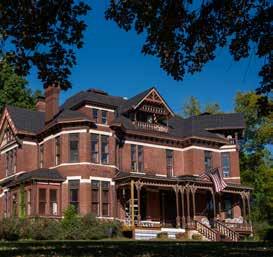

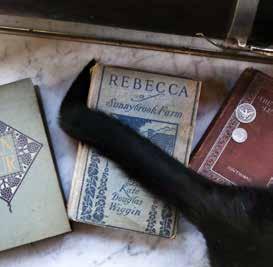
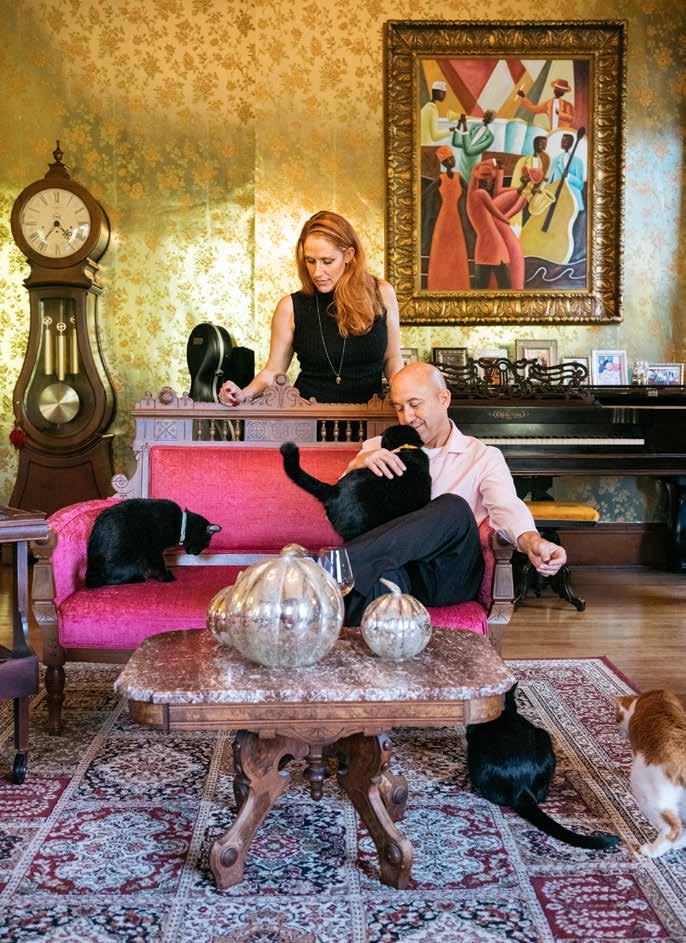
“THE LOST AND THE DISCARDED FIND THEIR WAY HERE — BECAUSE WAYWARD CATS COME IN MANY FORMS.”
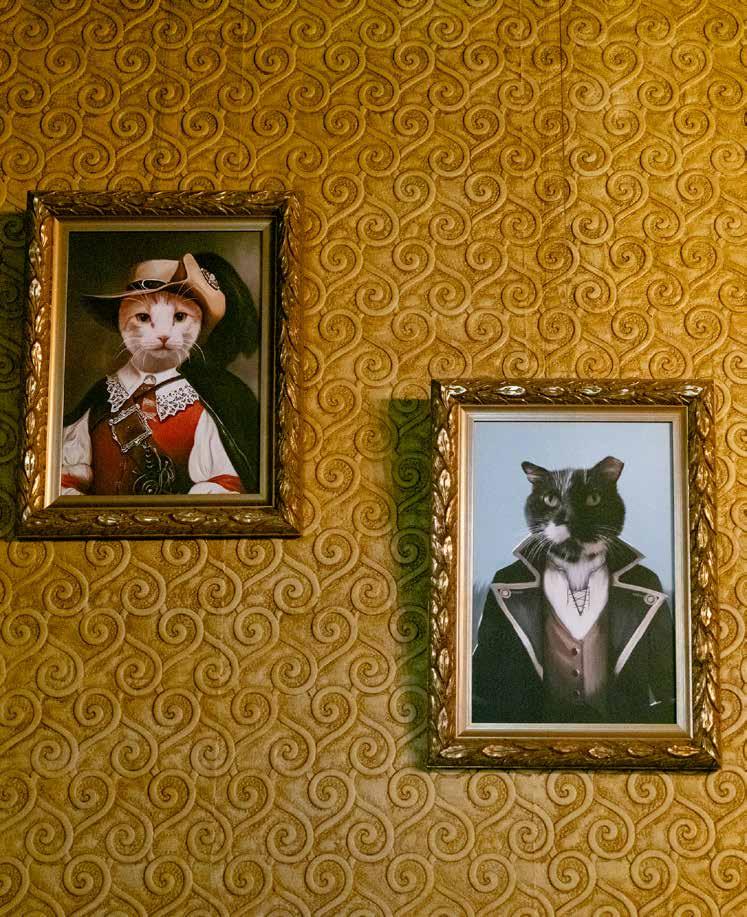
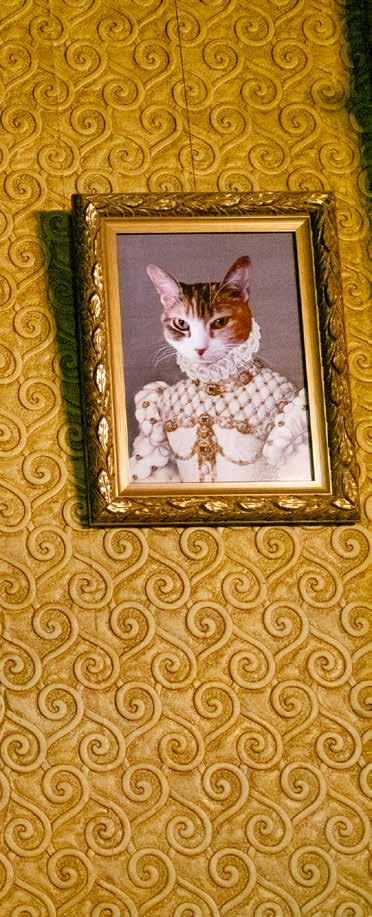
This is not to in any way imply that our new life at The Manor has been full of treasure, carefree frolics with wildlife, and an abundance of new friends. Two months after moving in, our first contractor stole ten thousand dollars from us and disappeared. Our first Easter in the home, the old stove caught on fire and we wound up cooking on a hot plate for the next six months. A month later, on the first hot day of the summer, two of the three HVAC systems went out, creating sweaty, clothing-optional days when the temperatures breached the triple digits. Delays in the kitchen renovations left us without running water downstairs for several months, and we wound up washing our dishes on the back patio in a plastic tub.
It was kind of like being in college again, but with raccoons.
And also, as the name Krasnesky Manor for Wayward Cats implies, there were the cats. We brought our clowder along with us when we moved, all of them rescues and special needs animals. One of them, No Tail, a cat that I rescued from Afghanistan after my last deployment, became the unofficial spokes-cat for The Manor, although all of the permanent residents here have distinctive voices and personalities that they communicate in their frequent postings.
In addition to the permanent residents, other waywards continue to find us. The strays and the hungry find their way to our back door, as well as injured cats, but also the occasional injured deer or raccoon or even person. The lost and the discarded find their way here — because Wayward Cats come in many forms.
Several months ago, my eldest daughter, Rachael, called me in tears. She was on her way to the emergency room. She was pregnant and was suffering the same issues that had caused her to have a miscarriage the previous year. Her husband was on the way to the hospital to meet her, but she was still fifteen minutes away and so frightened that she was about to lose this baby as well. She was four hours away from me and I could do nothing, but I was out in the garden when she called and so I stayed on the phone with her for the rest of her journey and talked to her about the flowers. I didn’t tell her everything was going to be alright. I didn’t tell her she needed to calm down. I just told her about which flowers liked more sun, which ones drew the most bees, and which ones had been nibbled on yet again by the deer and the groundhogs. By the time she reached the hospital, her panic had left her and her breathing had returned to normal.
I hadn’t done anything for her physically, but for those fifteen minutes, it had been enough to let her set aside the more immediate concerns and listen to me talk about the flowers. It struck me that if it had helped her, it might help others as well. So, on our social media page, I wrote a post and made the offer that if anyone needed a break from whatever was troubling them or creating panic in their lives, they were invited to come out to the house, and if I was out in the garden, as I am most weekends, they could simply walk up to me and say, “Tell me about the flowers.” I wouldn’t ask them any questions about why they were there or try to counsel them in any way. I would simply spend the next fifteen minutes with them, telling them about the flowers.
The magic of The Manor was probably most evident two months after that post when a young couple walked up our driveway.
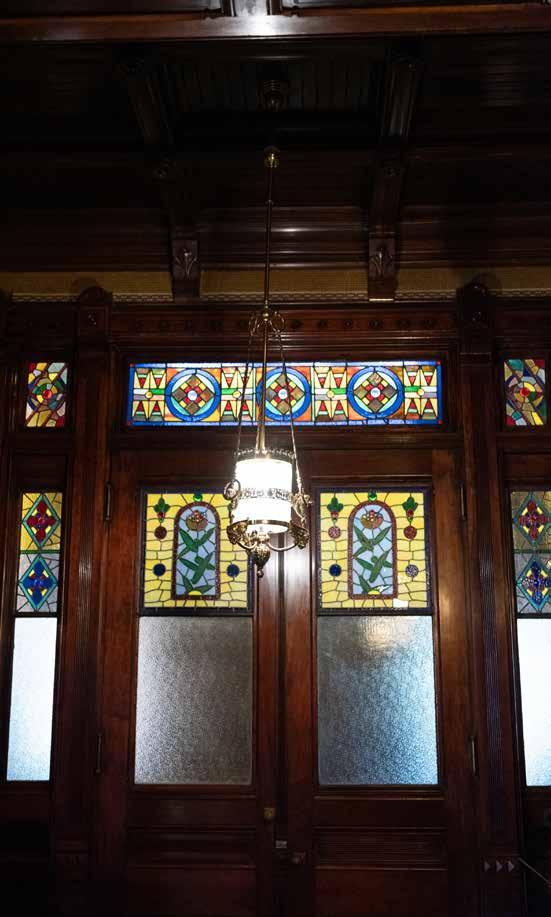
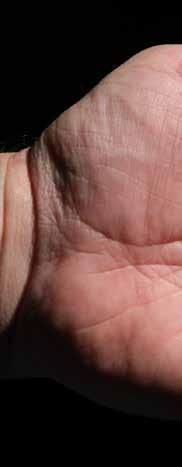


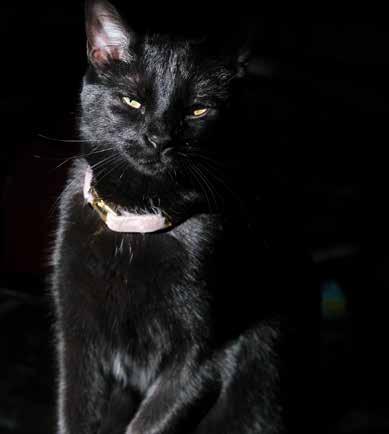
I was out in the garden and covered in dirt when they arrived. The woman stepped forward cautiously and held out her hand, and as I took her hand in mine and shook it, she simply said, “Tell me about the flowers.” And for the next fifteen minutes, that’s what I did. Afterward, I went inside to give them some time alone.
Robin was standing at the kitchen window, looking out at the garden when I came inside.
“They wanted to know about the flowers?” she asked.
“Yes,” I replied.
And although I said in the post that I wouldn’t ask questions, this case was a little different. The husband had messaged me privately because his wife’s father had recently passed away, and when he asked what he could do to help, she had told him that she wanted to go to The Manor and have me tell her about the flowers. He was writing ahead to make sure that I would be home because we were in Kansas and they were traveling quite a distance.
“Do you know where they are from?” Robin asked.
“Seattle,” I replied.
Robin’s mouth fell open, and there were tears in her eyes. There were tears in my eyes as well, as I put my arm around her and we both turned to look out into the garden.
When things are lost, they find their way here, because Wayward Cats come in many different forms.
Thad and Robin Krasnesky’s daughter Rachael welcomed her first child, Eleanor, into the world in October. You can follow along Robin and Thad’s adventures and their rescue work on their Facebook page, Krasnesky Manor for Wayward Cats. Thad’s next book, “The Tale of No Tail,” a memoir about his rescue and relationship with a stray cat from Kabul, will be released in 2025.










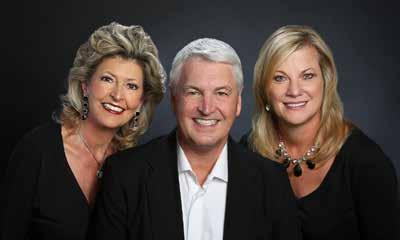




ARTICLE AND PHOTOGRAPHY BY KATIE CURRID
The Last Tobacco Farms of Missouri
Every tobacco plant for Missouri's remaining eight tobacco farms starts off in Lennie Callaway's greenhouse
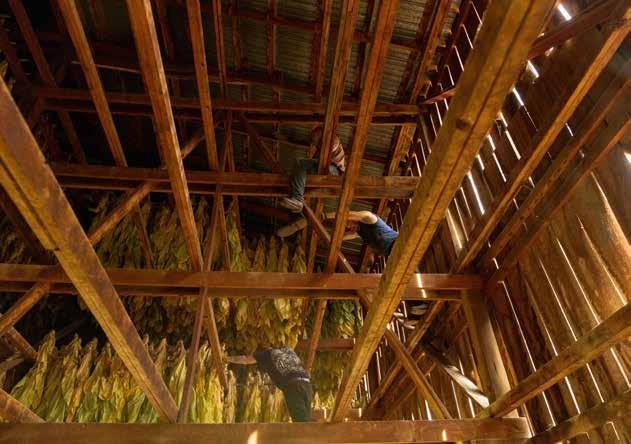
The birth of tobacco farming in Weston is usually recognized as 1894. Many people who settled Weston at this time were from Kentucky, Tennessee and Virginia. As they settled the Missouri River Valley, they brought with them the crop they knew best, establishing the only tobacco market west of the Mississippi River throughout the state.
Throughout the next century, the tobacco industry flourished in Weston, averaging five million pounds of tobacco at the local auction houses per year – most of it burley tobacco, used in cigarettes. The federal tobacco program was created
in 1938, a national government program that controlled the quantity of American tobacco, attaching quotas to tobacco-producing land and guaranteeing a price for all tobacco farmers if it carried a government grade. The Kentucky poet Wendell Berry once wrote, “Because of ‘the program,’... the tobacco market was the only market on which the farmer was dependably not a victim.”
During those good years, tobacco farming shaped Weston and Platte County and ruled the calendar.
In May, fields would begin to fill with baby tobacco transplants, set there by hand by folks riding on a tobacco setter pulled by a horse or mule, and later by simple tractors. On the hottest summer days, as the tobacco reached the shoulders of the help in the fields, it would be cut down by hand with tobacco knives in a sweat-filled process. The tobacco would then be housed in the iconic wooden tobacco barns dotting Weston’s rolling hills. The crop would be handed up from person to person standing on wooden rails, until acres of heavy, dripping wet tobacco leaves filled the ceiling above. The tobacco leaves would then be left to cure for weeks, aided
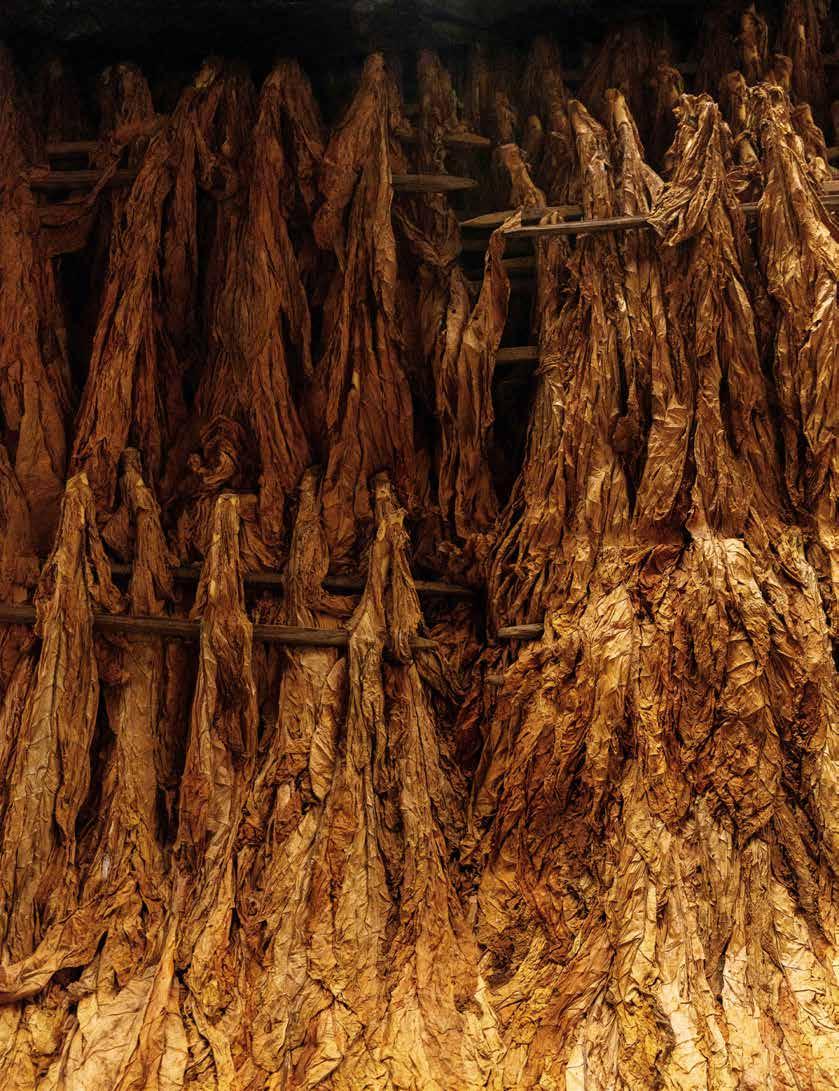
by air circulating through large gaps in the wooden siding of the tobacco barns, turning from green to yellow to brown, bringing the ubiquitous earthy aroma of tobacco to fill one’s nostrils as the days cooled and stripping time grew closer.
In November, the tobacco auctions started and happened four days a week until February. Weston had two auction houses — the Burley House and, opening in the 1970s, The New Deal Warehouse. The warehouses would start to fill up with the tobacco harvest, made up of tied “hands” of tobacco leaves in the early years, and later, with generously stuffed bales that had been stripped and sorted by farmers into different tobacco grades — flyings, brights, reds, etc. Government graders and fedora-topped buyers from companies such as Philip Morris would spend winter months walking the rows of dried leaves, cigarettes lodged in the corner of their mouths, naming prices and buying up pounds and pounds of tobacco.
Throughout the 20th century, the majority of folks in Weston were involved in some part of the tobacco process, no matter their age or gender.
CONTINUED >
“Every tobacco plant that finds its way into Missouri soil starts inside Lennie
greenhouse.”
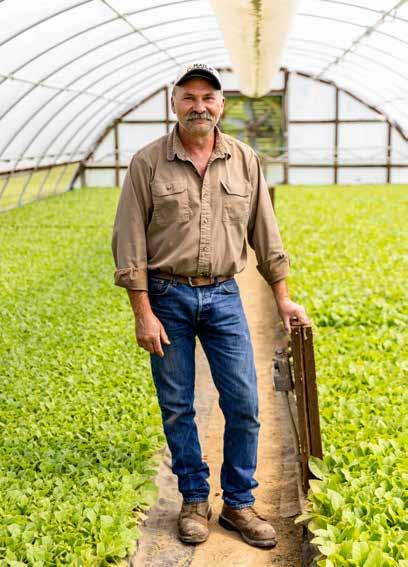
Callaway’s Weston
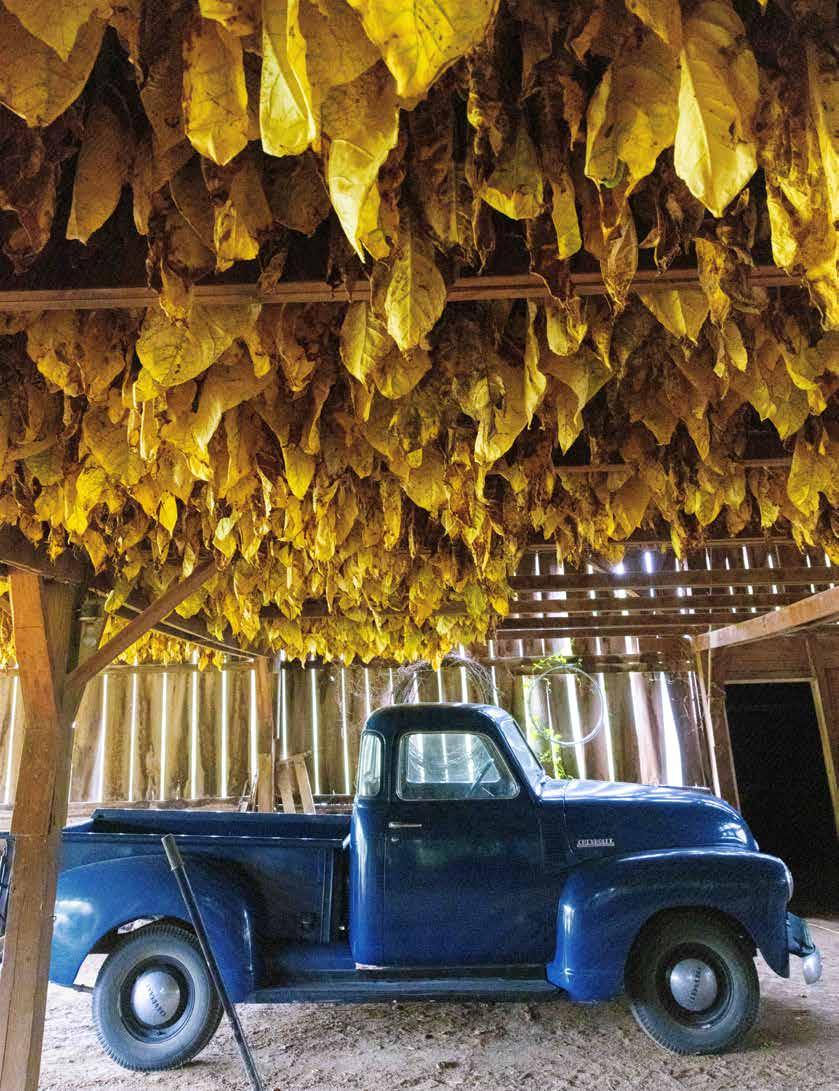
The best year on record was 1994, when the Weston market produced 8 million pounds of the crop, bringing in over $14 million to the local economy. But despite the great success of 1994, the beginning of the end of Weston tobacco was just ten years away.
In 2004, the national government ended the federal tobacco program and with it the tobacco auctions, the reasons political, global, health-related and, of course, conspiracy-laden in nature. The tobacco industry shifted from land-based quotas to contracts with individual tobacco farmers. Philip Morris had most of the contracts in Weston during this time, until 2015, when those went away, too. Tobacco in Missouri wasn’t quite dead, but its descent had begun.
Today, there are only eight tobacco farms left in the state of Missouri, and every tobacco plant that finds its way into Missouri soil gets its start inside Lennie Callaway’s Weston greenhouse. Lennie has been in tobacco fields since he was a boy and is now in his 50s. He started as a sharecropper, working in a thriving tobacco market until he bought his own farm at the age of 29. He has seen the peak of the days of farming tobacco, and, is now seeing its final days, his tobacco crop dwindled down to a fraction of its size, and his days now spent at a full-time job outside of his farm. He once raised over 23 acres of tobacco full-time and is now managing two to three, working the fields and stripping the leaves of the stalk on nights and weekends.


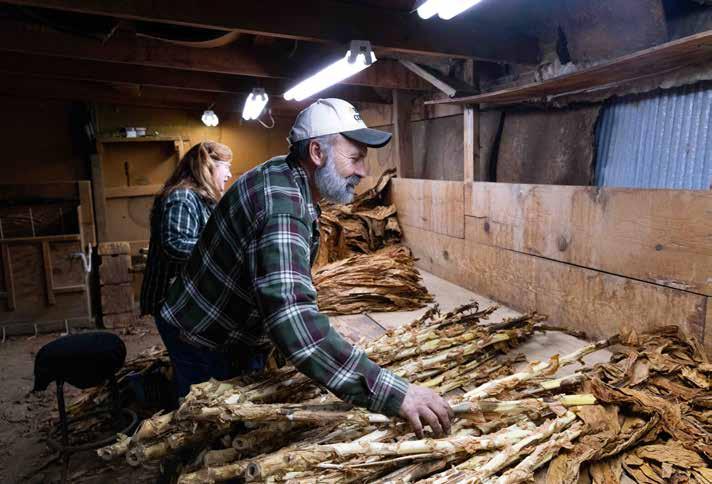
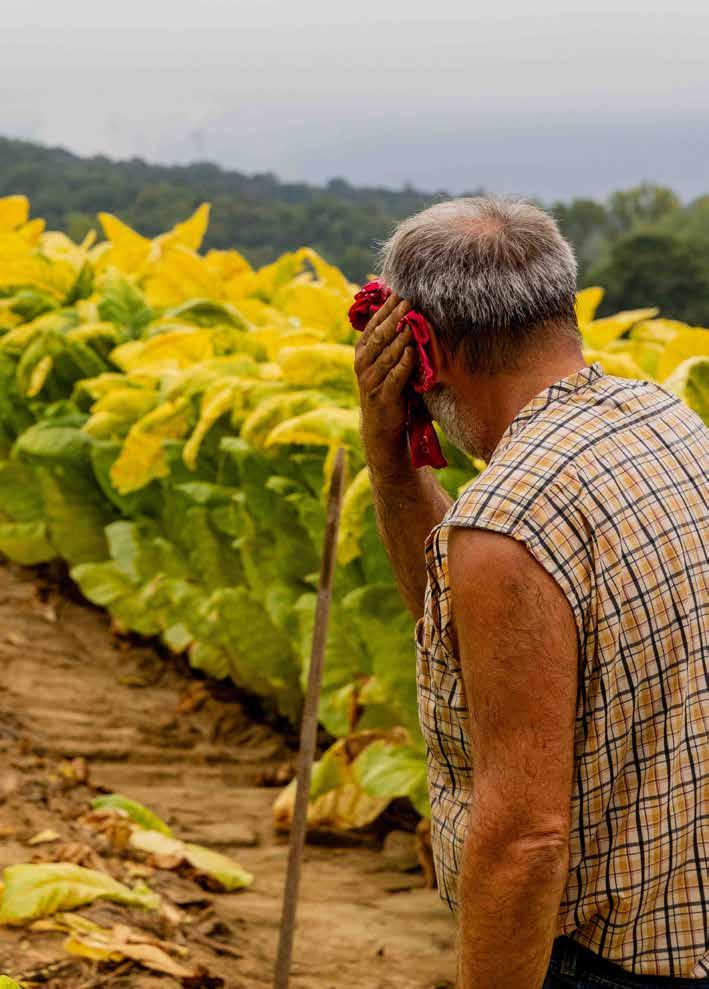
Nowadays, it’s hard to find enough help for Lennie to raise the amount of tobacco he used to handle. While other crops have benefitted from industrialization and technology, burley tobacco is delicate and still primarily needs to be handled by hand. Lennie has a trusted group of old friends that come out to set the tobacco, cut it from the fields and hang it in his barn with him, the latter a laborious process that happens on some of the hottest days of the year but one
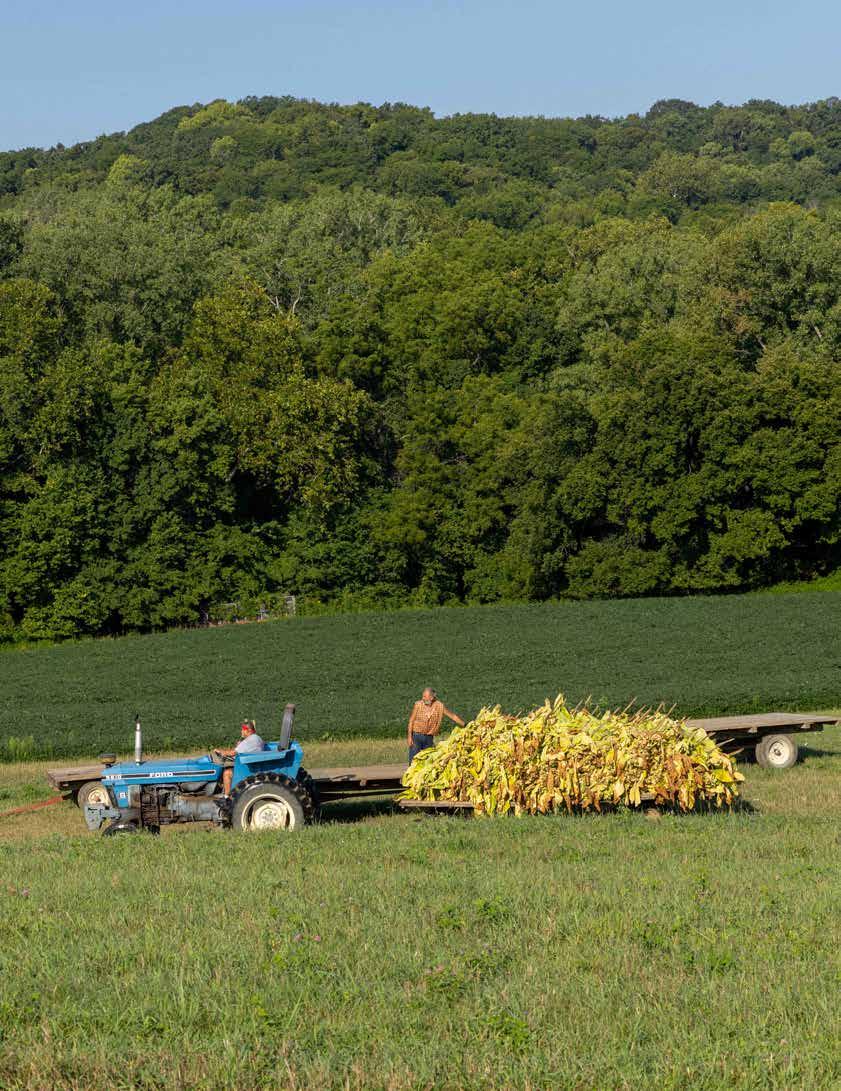
that his crew manages to fill with jovial laughter and camaraderie.
In the winter, he spends nights and weekends when he’s not at work in his stripping shed, sorting tobacco leaves that he strips from a stalk and piling them into bales while people stop by to talk to him as he works. These days, the tobacco gets loaded up and taken all the way to Hail & Cotton in Springfield Tennessee — a much further drive than when it went right down the road to one of the many Weston auction houses.



dip -giving
ARTICLE BY ANGELA BROOCKERD PHOTOGRAPHY BY JANIE JONES
Fall is synonymous with gathering with friends and family and enjoying time together. Whether it is for Thanksgiving, a football watch party or a simple fall gathering, these easy appetizer dips are the perfect shareable snack to share.
garlic herb feta dip
ingredients:
• ½ cup plain Greek yogurt
• 1 whole garlic bulb, roasted
• 1 ¼ cup feta cheese
• 3 teaspoons olive oil
• 1 Tablespoon lemon juice
• ½ teaspoon dill
• 1 teaspoon parsley
• Salt and pepper to taste
fig & honey brie
ingredients:
• 8 ounce brie wheel
• 1/3 cup fig spread or jam
• ¼ cup pecans
• 2 teaspoons honey
• 1 teaspoon fresh rosemary, chopped
• 1 teaspoon fresh parsley
directions:
First, cut the head off of the top of the garlic bulb, and drizzle olive oil on top. Wrap in foil, and place it in an oven heated to 425 degrees. Roast for 30 minutes or until soft. Squeeze roasted garlic into a bowl, and set aside. Next, add the yogurt, feta, lemon juice, salt, pepper and water in a blender and lightly blend. Add the roasted garlic and blend until smooth. Transfer to a serving dish and sprinkle with fresh herbs. Serve with crackers or fresh vegetables. Enjoy!
directions:
Place brie in a baking dish. Spread the fig spread on top of brie and sprinkle with chopped pecans. Drizzle with honey. Add fresh herbs, and bake at 350 degrees for 20 minutes. Serve with pita chips or crackers.
creamy pumpkin cheesecake dip
ingredients:
• 8 ounces softened cream cheese
• 1 can pumpkin puree
• ¾ cup brown sugar
• 1 cup heavy whipping cream
• 1 tablespoon pumpkin pie spice
directions:
Place cream cheese in a microwave safe bowl, and soften for 30 seconds. Add brown sugar and blend with a hand mixer until smooth. Add in pumpkin and blend until combined. Mix in heavy whipping cream and mix on high for 2 minutes. Next, stir in pumpkin pie spice. Serve with sliced apples, pretzels, graham crackers or vanilla wafers.








NOVEMBER 2024
events
A SELECTION OF UPCOMING LOCAL EVENTS
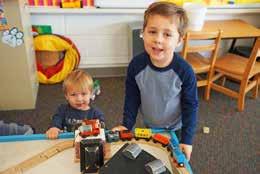
Explore Oakhill, an independent private school in Northland Kansas City, where students thrive and potential unfolds. From Pretoddler (18-months) through Grade 12, our community empowers growth, values uniqueness, and inspires excellence in every student

Now enrolling students in Grades
Pretoddler (age
NOVEMBER 7TH
Oreo Taste Test

- 12th
Grade
From Learners to Leaders

Day School will seek diversity in its student body and welcome enrollment by students of any race, color, national or ethnic origin, gender or sexual orientation, and any other characteristic protected under applicable law. It prohibits unlawful discrimination, harassment, and retaliation on the basis of any protected category under applicable federal, state or local laws or ordinances, including but not limited to Title VI of the Civil Rights Act of 1964 (Title VI), Title VII of the Civil Rights Act of 1964 (Title VII), Age Discrimination in Employment Act of 1967 (ADEA), Title IX of the Education Amendments of 1972 (Title IX), the Americans with Disabilities Act (ADA), and Section 504 of the Rehabilitation Act of 1973 (Section 504), specifically, but not limited to, discrimination, harassment, or retaliation on the basis of sexual orientation, gender or sex, race or ethnicity, ethnic group identification, ancestry, nationality, national origin, religion, color, mental or physical disability, age, or on the basis of a person’s association with a person or group with one or more of these actual or perceived characteristics in Oakhill Day School’s educational programs or activities.
North Kansas City Public Library | 4:00 PM
Join us for a deliciously fun library program where we’ll sample a variety of Oreo flavors and vote for our favorite! From original to intriguing new flavors like pumpkin spice and birthday cake, this tasting event promises a treat for your taste buds. Register at nkcpl.org
NOVEMBER 9TH
Hand Knitting
North Kansas City Public Library | 9:00 AM
Come learn and create a hand-knitted lapghan blanket! You will learn how to cast on, the basic stitch, how to join your yarn, and how to cast off. You will have a lovely lapghan at the end of the session and the tools to then knit your own wonderful creations. Find a supply list and register at nkcpl.org
NOVEMBER 14TH
Friendship Bracelets
North Kansas City Public Library | 4:00 PM
Join us for an afternoon of crafting. We will have a variety of beads for you to make bracelets for yourself or to share with others. Register at nkcpl.org
NOVEMBER 16TH-17TH
Mistletowne Market
NKC Parks & Recreation Center: 1201 Clark Ferguson Drive, North Kansas City | 10:00 AM
A unique two-day indoor shopping event combining local holiday shopping, children’s activities, and festive entertainment. A small, thoughtfully-curated artisan holiday market filled with local fine art and maker goods. The perfect destination to pick up one-ofa-kind gifts for your loved ones for the holiday season. Market hours are Saturday 10-6 and Sunday 10-4. For more information, visit artsinthepark.org
NOVEMBER 29TH-30TH
Weston Wassailing Market
Historic Weston Orchard & Vineyard, 18545 Co Rd H, Weston | 12:00 PM
An old world-style outdoor Christmas market including food, wassail, artisan vendors, roaming storytellers, woodland Santa, activities for all ages, and lots of Christmas magic at the Historic Weston Orchard. For more information, email westonwmarket@gmail.com.
NOVEMBER 30TH
Small Business Saturday
Historic Downtown Liberty | 9:00 AM
Get ready for the holiday season by supporting local small businesses in Historic Downtown Liberty on November 30th, Small Business Saturday! This is the perfect opportunity to find unique gifts for your loved ones while supporting the local businesses. Don't miss out on the chance to shop small and make a big impact.
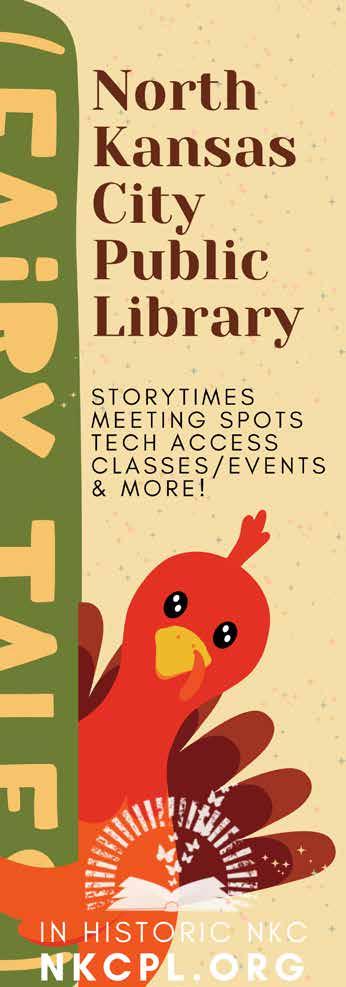
DECEMBER 6TH
Celebrate the holidays in Parkville at Christmas on the River!
Downtown Parkville | 5:00 PM
Bring the family and enjoy the festivities, including Parkville’s inaugural Christmas Market and entertainment starting at 6 pm. You can enjoy holiday treats, take photos and visit with Santa Claus, listen to live music, participate in crafts, write letters to Santa, and view a fireworks display along the river at 8:45 p.m.
DECEMBER 7TH-8TH
Historic Candlelight Homes Tour
Throughout Weston | 12:00 PM
For over four decades, Weston homeowners have opened the doors to their historic homes and welcomed visitors for the holidays. Weston shops will be all decked out for the season, and our Santa will be strolling the streets along with holiday carolers. Shuttles will run on both days. Find more information or buy tickets at westonmo.com
DECEMBER 7TH
Art Class: Holiday Gelli Prints
Orange Easel Liberty Studio: 249 W Mill Street, Ste 107, Liberty | 10:00 AM
Come explore the world of monoprinting! We'll use gelli plates, acrylic paints, and holiday-themed masks/stencils to create one-of-akind artwork. After a demonstration and plenty of playing and experimenting, each artist will pick their favorite print to finish with a 11x14 inch mat. For artists Kindergarten and up. Registration required. Register at orangeeaselart.com
DECEMBER 7TH
Art Class: Winter Pine Cone Trees
Orange Easel Platte Woods Studio: 7617 NW Prairie View Road, Kansas City | 10:00 AM
In this 90-minute workshop, artists will create a colorful holiday tree sculpture! Our trees are actually pinecones with a wood base. Decorations include paints, pom-poms, tinsel, glitter, and puffy "snow paint." In addition to the project, artists will get to explore our creative play stations. For ages 3-6 years. Registration required. Register at orangeeaselart.com
Simply the best.







